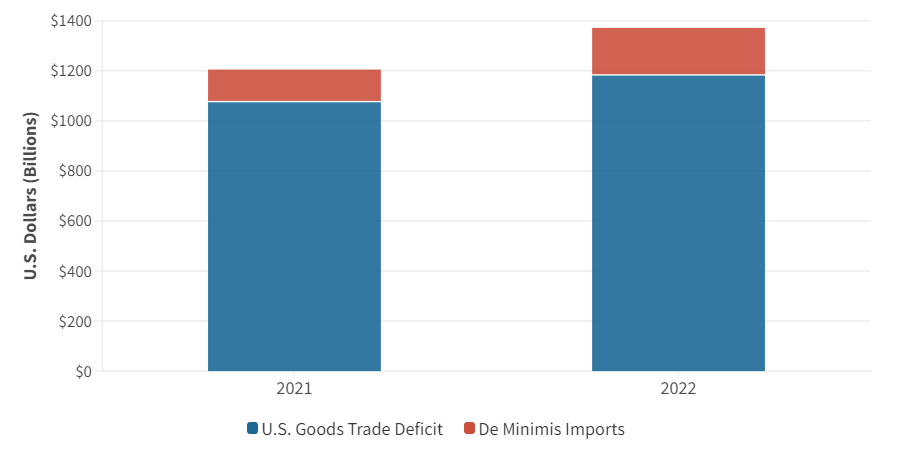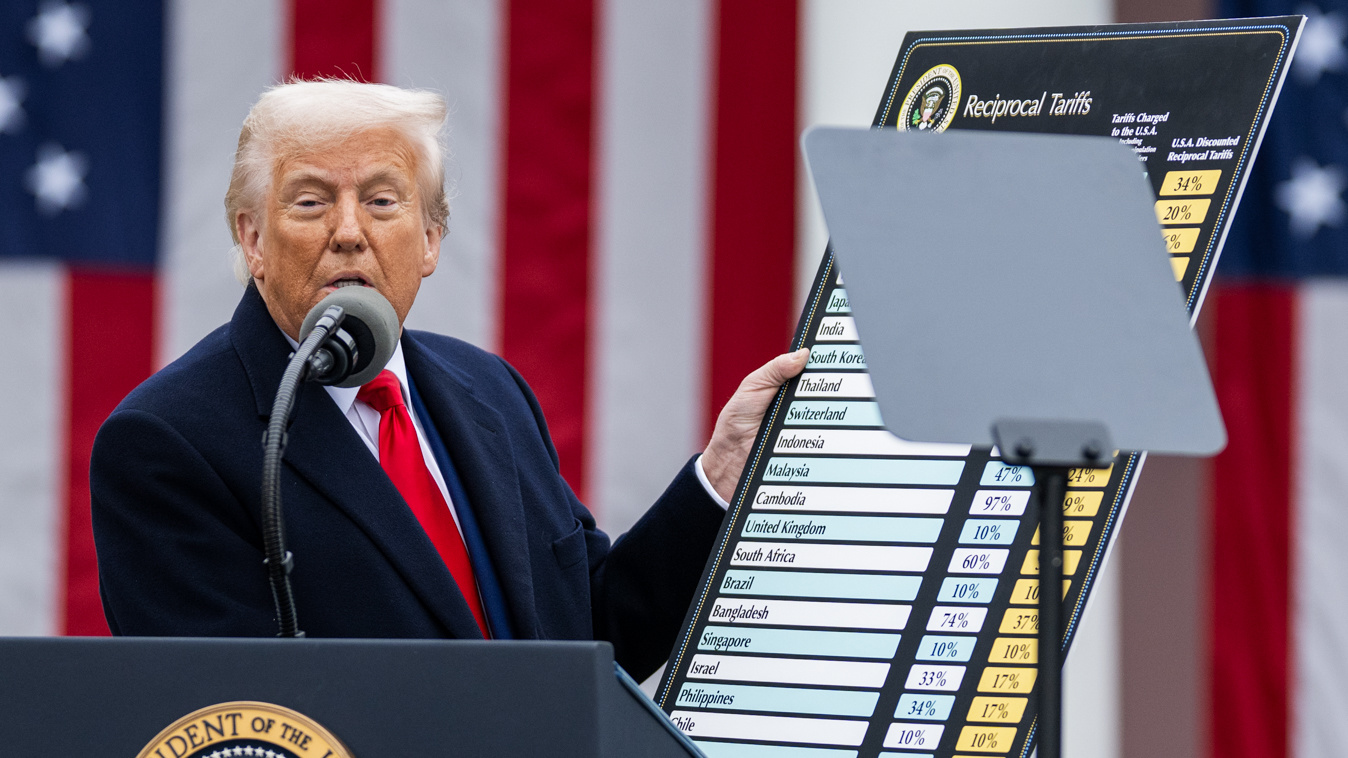Key Points
- Our new estimate puts de minimis China revenue last year at $187.9 billion.
- The uncounted imports increase the actual 2022 U.S. goods trade deficit by 16% from $1.19 trillion to $1.38 trillion, representing some 8.3 million lost U.S. jobs.
- De minimis imports are deeply damaging to U.S. manufacturing industry and U.S. brick and mortar retailers.
- With the incursion of Chinese-owned retailers like Shein and Temu into the U.S. market, we may be witnessing a historic shift away from U.S.-owned e-commerce giants like Amazon.

Note: Official goods trade deficit (blue bars) from U.S. Census. De minimis China estimates (red bars) from CPA calculations.
De minimis is a loophole in U.S. import regulation and U.S. tariffs on China large enough to drive an elephant through. The de minimis provision in customs law allows any foreign company or individual to ship duty free directly to U.S. consumers provided that the order total is below the $800 amount. This allowance has contributed significantly to undermining the rule of law, the offshoring of U.S. manufacturing industry, the decline of U.S. consumer goods brands, and erosion of the business of thousands of U.S. retailers, who are forced to compete with goods coming in online from overseas, sent by foreign companies who do not pay U.S. tax and break U.S. safety laws and consumer regulations with impunity.
We estimate that last year, the U.S. imported $187.9 billion worth of goods from China under the de minimis rule. These imports were not counted in the official government import statistics published monthly by the U.S. Census. The official Census figures state that the U.S. imported $536.8 billion of goods from China last year. If you add our de minimis estimate and the official figure together, you get a total of $725 billion of U.S. imports from China.
De minimis from China adds $187.9 billion to our trade deficit. Last year our trade deficit reached a record total of $945 billion on the goods and services account and $1.19 trillion for goods alone. Including our de minimis estimate, the trade deficit would have been much higher, at $1.13 trillion for goods and services and $1.38 trillion for the goods only trade deficit. There is a rule of thumb that every $1 billion of imports costs us around 6,000 jobs. On that basis, the $188 billion of de minimis China imports cost us last year 1.1 million lost jobs, on top of the 2.3 million jobs that can be attributed to our official China goods deficit last year of $383 billion.
It is not simple to develop an estimate the value of de minimis shipments into the U.S. By allowing shipments into the U.S. with minimal documentation, the de minimis law makes it much harder to measure the volume and value of those imports.
Last year, we looked at three sources to help us develop a 2021 estimate: individual company reports, total U.S. retail sales data from the U.S. Department of Commerce, and U.S. Customs and Border (CBP) patrol reports on de minimis. However, last October CBP published a report claiming that the value of de minimis imports fell in 2021 by some 40% to $39 billion. Such a huge fall of de minimis imports at a time when consumer spending was rising and conventional imports were surging was simply not credible. My colleague CPA Trade Counsel Charles Benoit investigated the CBP report and CBP confirmed that their “total value” figure only consisted of de minimis shipments where a value declaration had been electronically submitted. De minimis shipments with electronic data submissions were a minority of the 771.5 million de minimis shipments in CBP’s Fiscal Year 2021, thus guaranteeing that the true figure was much larger. (Read more at CPA’s note: CBP Released False Government Statistics.) Our view is that CBP has no idea of the true value of all de minimis shipments into the U.S., for the simple reason that no one is manually tabulating the hundreds of millions of de minimis shipments where the declared value is only written on the side of the package. Furthermore, the declared value is made by the overseas sellers, who are totally outside U.S. jurisdiction. They have every incentive to undercount the true value, and it is completely unrealistic to expect CBP to challenge these value declarations as the value is based on the value in the country of shipment, not in America.
Individual private company reports are often a more reliable source of information than government reports, because under securities law, company executives can be held criminally liable for false or misleading information issued by the companies they work for. Government officials on the other hand are rarely penalized for releasing incorrect statistics. It is plausible that CBP released very low estimates of de minimis volume and value as a result of political pressure by the e-commerce industry and the international package delivery industry, both of which have strong economic interests in allowing de minimis shipments to continue to grow, preferably out of the public spotlight.
The CPA De Minimis Estimate
We utilized reports by some of the largest e-commerce companies to build a bottoms-up estimate of de minimis China revenue for 2022. The dominant force in online e-commerce in the U.S. is of course Amazon.com. Amazon reports the sales of its e-commerce division in North America. Last year, that figure was $315.9 billion. The U.S. accounts for about 90% of spending in North America, so Amazon’s U.S. sales last year were some $284.3 billion. Amazon does not disclose the origin of the products that made up its $284.3 billion of U.S. sales. But a number of market research firms study the e-commerce market, providing information to e-commerce sellers for a fee and some information for free on their website. Research firm Marketplace Pulse estimates that 48% of Amazon’s third-party sellers are based in China. “American sellers still make up more than 50%, but they will likely soon dip below,” that figure, commented Marketplace Pulse in a November 2022 article.
The term third-party sellers refers to independent companies that use the Amazon website as a platform to reach Amazon’s millions of American customers. Amazon also sells products it sources itself. We assume that 40% of Amazon’s revenue comes from China-based products or sellers, a conservative estimate in view of the Marketplace Pulse data. We further assume that all of this revenue comes in via de minimis, i.e. the value of all sales is under $800. This gives us a total of $126.4 billion of de minimis imports from China just for Amazon.
As Table 1 shows, we have used a similar combination of financial reports and estimates to develop estimates of de minimis China imports for other leading online sellers. Walmart management has talked about its goal of building its online business, and the available data suggests it is marching up the ranks of U.S. online merchants selling Chinese-made goods. Other sellers, such as eBay and Wayfair saw their sales stagnate in 2022, as retail sales cooled down from torrid growth in 2021. The U.S. Department of Commerce has estimated that total U.S. e-commerce sales in 2022 grew 7.7% to total $1.03 trillion, the first time e-commerce has surpassed a trillion dollars.
Table 1. U.S. de minimis imports from China reached $187.9 billion in 2022
| Company | Global Revenue 2022 ($M) | US revenue ($M) | Online US revenue ($M) | Share from de minimis China (%, est.) | De minimis China online US revenue ($M) |
| Amazon (Retail business) | $ 433,880 | $ 284,292 | $ 284,292 | 40% | $ 113,717 |
| Ebay (GMV) * | $ 73,900 | $ 35,910 | $ 35,910 | 40% | $ 14,364 |
| Walmart | $ 572,800 | $ – | $ 39,325 | 40% | $ 15,730 |
| Target | $ 107,600 | $ – | $ 20,014 | 25% | $ 5,003 |
| Wayfair | $ – | $ – | $ 10,500 | 50% | $ 5,250 |
| Etsy (GMV) * | $ 13,318 | $ 7,858 | $ 7,858 | 30% | $ 2,357 |
| Best Buy | $ – | $ – | $ 14,210 | 35% | $ 4,974 |
| Subtotal US-owned sellers | $ – | $ – | $ 412,108 | $ 161,395 | |
| Chinese companies | |||||
| Shein | $ 30,000 | $ – | $ 15,000 | 100% | $ 15,000 |
| Anker | $ 20,956 | $ – | $ 10,478 | 100% | $ 10,478 |
| DJI | $ 4,000 | $ 1,000 | $ 1,000 | 100% | $ 1,000 |
| Subtotal China-owned sellers | $ – | $ – | $ 26,478 | $ 26,478 | |
| Grand total | $ 438,586 | $ 187,873 | |||
| * GMV (Gross merchandise value) refers to the sale value of all goods shipped by these platforms. eBay and Etsy report GMV values in addition to their own direct revenue. | |||||
| Source: Company reports, CPA calculations | |||||
This year, for the first time, we included China-headquartered online sellers into the U.S. market. We included just three such sellers (see Table 1), led by Shein. It can be very difficult to get accurate financial figures for Chinese companies. Shein has yet to disclose its annual revenue. Last year, they were exploring a stock offering, which led to speculation on Wall Street about their size. The speculation put Shein’s 2022 revenue at $30 billion. Since Shein was implanted in other markets around the world before it entered the U.S. market, we estimated that only half of the total was for goods sent to the U.S. All of Shein’s low-priced, so-called “fast fashion” clothing is made in China.
The other two Chinese sellers on our list are Anker, a maker of small electronics such as power supplies and chargers, and DJI, the world’s leading maker of drones. DJI is a private company and does work for the Chinese military, so the Chinese Communist Party ensures that it keep its financials very private. We are fairly confident that our $1 billion of U.S. revenue for DJI is an underestimate. Like other online sellers based in China, DJI carefully targets the U.S. market, with products like the DJI Mini 3 Pro, a sophisticated drone that comes equipped with video camera, remote control, and tracking software, all for $769. Note that the pricing, a mere $31 below the $800 de minimis threshold, is carefully designed to make it easy for Americans to buy. DJI delivers in two days, thanks to warehouses in the U.S.
We have not included Temu, a Chinese seller that launched in the U.S. last fall. Its owner, Chinese conglomerate Pinduoduo, has not yet broken out regional sales data for Temu. But Temu’s ambitions are large. It’s likely that by this time next year, Temu’s U.S. annual sales rate will be well over $1 billion a year. It is in the same market as Amazon and Walmart, aiming to sell almost anything a consumer would buy and at low prices.
When we add all our figures together, we come to a total of $187.9 billion of de minimis China shipments into the U.S. last year. The U.S. is of course the world leader in goods imports, with $3.3 trillion of imports last year. That figure does not include de minimis imports. If the “invisible” (to the Census number-crunchers) de minimis imports from China were its own nation, it would be the 28th largest importer in the world.
We are confident our estimates are conservative, for two important reasons: first, we have only estimated de minimis China imports for a handful of U.S. and Chinese companies. There are dozens or hundreds more companies that sell products online to U.S. consumers. As an example of the growth momentum, we only need look at Shopify’s financial results. Shopify is a Silicon Valley firm that manages payments and other services for companies that wish to sell online. Its customers include household names like Mattel and Black and Decker. Last year, Shopify reported $197 billion of gross merchandise value, up 12% on 2021. We don’t know how much of that $197 billion represented Chinese goods bought via de minimis by U.S. buyers, but it is certain to be a significant percentage.
The second reason we are confident our figure is an underestimate is that for both Amazon and Walmart, our total does not include all third-party sales revenue in their published revenue totals. Their own revenue totals include only the money they earn from commissions and fees charged to third party sellers. If one assumes, just as an example, that of our estimated $114 billion of Amazon de minimis China revenue, one third of it came from third party sellers ($38B), and its fees totaled a quarter of the revenue that third party sellers charged consumers, then the total third-party imported merchandise value would be $152 billion. That would add another $114 billion to Chinese de minimis sales that went through the Amazon platform. This is a shockingly large figure.
Last week, at a House Ways and Means Committee hearing, Chairman Jason Smith (R-MO) and Rep. Earl Blumenauer (D-OR) criticized the de minimis loophole as, in Rep. Smith’s words, “a free trade agreement with China” that is deeply detrimental and costly to U.S. business.
We would propose that the committee hold hearings specifically on de minimis and ask major online retailers beginning with Amazon to state on the record the value of total de minimis and China de minimis imports they and their associated sellers brought into the U.S. last year.











